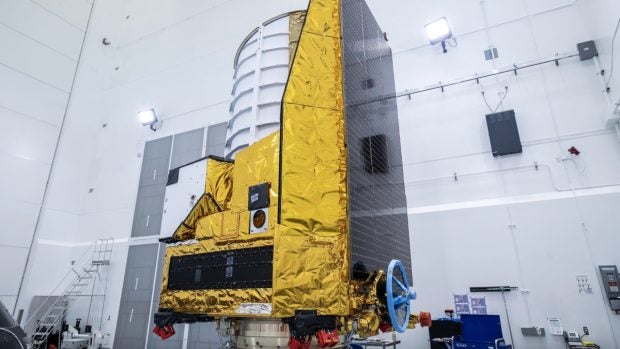
The Euclid spacecraft on an adapter that will later be attached to the upper stage of the Falcon 9 rocket. (Screenshot: Twitter)
The universe still holds many mysteries, and one of the most intriguing of these is the existence of dark matter and dark energy. To solve these mysteries, the European Space Agency (ESA) launched Project Euclid.
Euclid is a mission aimed at mapping the geometry of the universe and gaining a better understanding of dark matter and dark energy, which make up most of the energy balance of the cosmos.
Table of contents
The name Euclid comes from the famous Greek mathematician Euclid of Alexandria, who significantly shaped the form of geometry we know. The choice of this name is intended to reflect the close connection between the geometry of the universe and the distribution of matter and energy.
Editor’s Recommendations
The main goals of the Euclid mission are ambitious. The super telescope is designed to study the distance-redshift relationship and the evolution of cosmic structures. For this purpose, shapes and redshifts of galaxies and galaxy clusters are measured up to a retrospective time of ten billion years. This period covers the era when dark energy played a significant role in accelerating the expansion of the universe.
Euclid is supposed to answer some of the most important questions in cosmology:
- What is the structure of the cosmic web? How did it evolve?
- What is the nature of dark matter?
- How has the expansion of the universe changed over time?
- What is the nature of dark energy?
- Is our understanding of gravity complete?
To accomplish these tasks, Euclid has a powerful telescope with a diameter of 1.2 meters. The spacecraft itself is about 4.7 meters high, has a diameter of 3.7 meters and consists of a service module and a payload module. The payload module contains the telescope and two other scientific instruments, a visible wavelength camera and a near-infrared spectrometer. The service module houses the systems for power generation, attitude control, data processing, telecommunications and thermal control.
Euclid’s image quality will be at least four times sharper than that which can be achieved by ground-based equipment. In addition, Euclid will perform near-infrared spectroscopy of hundreds of millions of galaxies and stars in the same sky. This allows scientists to study the chemical and kinematic properties of many targets in detail.
Euclid will be launched on July 1, 2023 at 11:11 a.m. local time from Cape Canaveral, Florida (USA) on a SpaceX Falcon 9 launch vehicle. After launch, the spacecraft will be placed in orbit around the Sun-Earth Lagrange point 2. This point is at an average distance of 1.5 million kilometers beyond Earth’s orbit. Here Euclid will accompany Earth and observe more than a third of the sky outside our Milky Way.
Euclid’s nominal mission lifespan is six years, but it can potentially be extended. During this time, the space probe is to build up an extensive database from which future missions can also benefit.
The Euclid consortium, consisting of over 2000 scientists from 300 institutes in 13 European countries, the USA, Canada and Japan, provides the scientific tools and data analysis. Thales Alenia Space and Airbus Defense and Space are responsible for building the spacecraft and its instruments. NASA is also supporting its international colleagues in realizing this extensive project.
